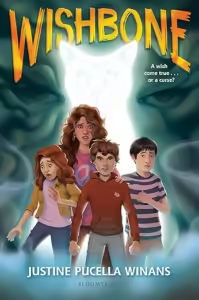Wishbone
Justine Pucella Winans
Publisher
Published September 17, 2024
Amazon | Bookshop | Goodreads
About Wishbone
Coraline meets Ghost Squad in this terrifying story about what happens when you aren’t careful what you wish for.
Ollie wishes things could be different. He wishes his parents would stop fighting. He wishes his sister Mia didn’t have to worry about paying for college. And he wishes people would accept him for who he is. Most of all, he wishes he wasn’t so angry about all of this.
When he and Mia find a two-tailed cat they name Wishbone, Ollie takes comfort in telling him everything he wishes would change—then, it does. Everything Ollie and Mia wish for comes true, and it’s like all of their problems are solved. But magic comes at a price. Their wishes have consequences, and a mysterious shadow man called The Mage is after Wishbone. Darkness is overtaking their world, and worst of all, it threatens to take over Ollie, too. Can he let go of everything he’s ever wanted, or will he let evil win?
My Review
I read The Otherwoods by the same author in 2023, and I enjoyed the spine-tingly elements of the story and how they ultimately played out. I’ve been meaning to read more by Winans, but it has taken me too long to get back to another of their books.
One of the things I knew I’d love about Wishbone is that it has a cat-who-is-not-a-cat character. Wishbone is a cat with two tails that has the inexplicable magical ability to grant wishes. He is feisty and prone to biting people, which makes sense, considering the trauma that he’s been through. I like the unpredictable nature of him as a character. For a long time, I wasn’t sure whether he was supposed to be good or bad. Eventually, he makes his alliances known and says pretty loyal to his people.
The book has a nicely inclusive cast. Ollie is a trans boy, but the book isn’t at all about him explaining his identity or existence. We enter his story past all of that, and he simply is who he is. He has other LGBTQIA+ friends and allies, too. The story touches on the impact of bullying and anger issues, and takes readers through a Twilight Zone kind of experience.
If you like scary stories like The Darkdeep by Ally Condie and Brendan Reichs, definitely check out Wishbone.
Content Notes
Recommended for Ages 10 to 14.
Profanity/Crude Language Content
None.
Romance/Sexual Content
References to a crush between Ollie and another character.
Spiritual Content
Another place/dimension Ollie calls The Backward Place contains magic and curses, including the ability to grant conditional wishes.
Violent Content
Situations of peril. Some characters try to kill other characters while under the influence of a curse. In one instance, a parent character tries to kill a child because of the curse. References to and a brief scene showing animal cruelty in an apparent science experiment.
Drug Content
None.
Note: This post contains affiliate links, which do not cost you anything to use but help support this blog. I received a free copy of this book in exchange for my honest review. All opinions are my own.
